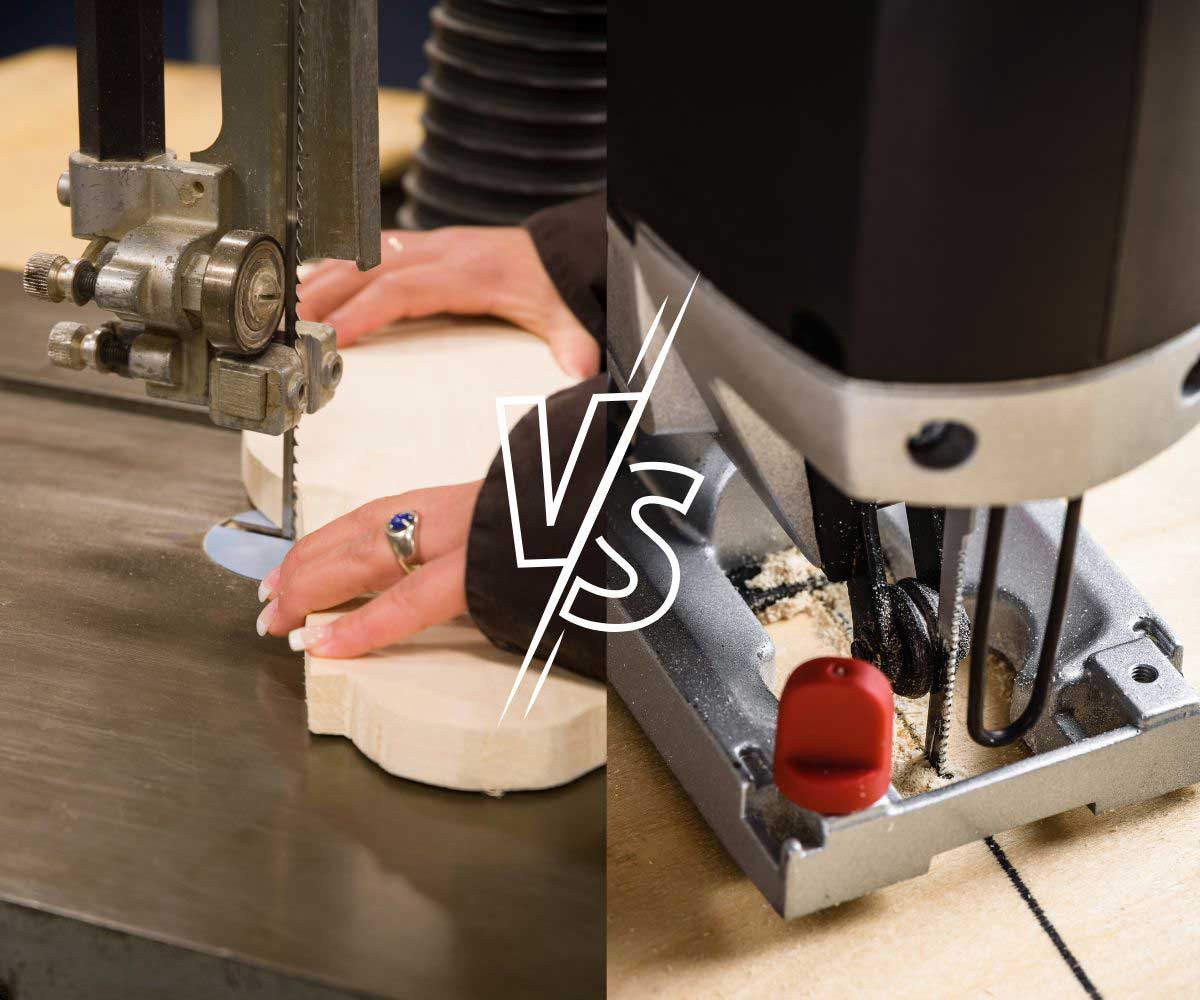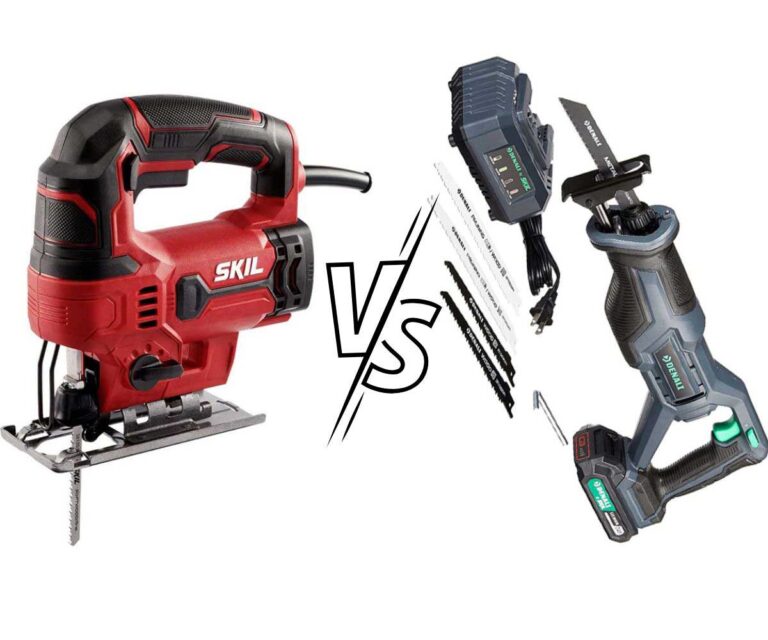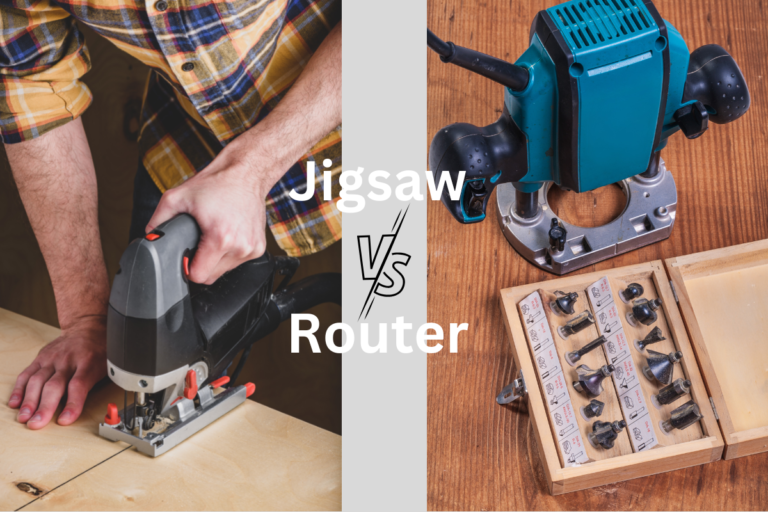Jigsaw Vs Bandsaw – Pick The Right One!
As an Amazon Associate I earn from qualifying purchases.
A jigsaw and Bandsaw tool allows you to slice on any pliable surface, like wood, particleboard, metal, plastic, tile, and plywood. But they are specially used for cutting wood.
On a Jigsaw, you can do curve cuts and make shapes better as its blades are small and narrow, and you can hold it in one hand to make cuts. On the bandsaw, you can make straight cuts better; but the narrow bandsaw blades can make the equation opposite.
As a beginner, it’s hard to identify which one is better in which context. So let’s elaborately compare and give you a clear idea between Jigsaw vs Bandsaw so that you can choose one of them according to their type of work.
Contents
Comparison Table Between Jigsaw and Bandsaw
| Features | Jigsaw | Bandsaw |
| Blade | Small | Large |
| Power supply | Corded and cordless | Corded and cordless |
| Inside cut | Yes | No |
| Curve cut | Better | Average |
| Straight cut | Average | Better |
| Deep cut | Less deep | Deeper |
| Changing blades | Easy | Tough |
| Safety | Less | Average |
| Maintenance | Easy | Tough |
| Portable | Yes | Yes |
Pros and Cons of Bandsaw Vs Jigsaw
Bandsaw
A bandsaw is a resawing power tool that uses continuous wide and narrow blades to make straight lines, angle lines, curved cuts, and complex designs.
A bandsaw can be of two types; one is a bench top, and another one is a floor-style bandsaw. The floor-style bandsaws are portable, allowing you to work outside anywhere.
Note: The floor-style portable band saws come in corded and cordless versions.
Jigsaw
A jigsaw or a saber saw is a handheld power tool that uses thin blades mounted on the upper body to provide carve cuts, straight lines, angle lines, and complex shapes on thin materials. Only you just have to select the right jigsaw blade.
On this handsaw, you can cut on the inside of a material without affecting the outside edge. This power tool comes in corded or cordless versions to give you the freedom to take them anywhere.
Comparison Between Jigsaw and Band Saw
They both have similarities in cutting various materials, but in performance and features, they have dissimilarities. So let’s get all similarities and dissimilarities between Jigsaw and Bandsaw.
Design:
A jigsaw is a handheld power tool with a reciprocating blade, while a bandsaw is a stationary power tool that uses a long, continuous blade.
Blades:
A jigsaw uses a straight reciprocating thin blade that moves up and down to cut and pull the chips out. The bandsaw uses a continuous blade that moves in a clock motion and cuts only in one direction.
Blade size: The blades of a jigsaw are smaller in size compared to bandsaw blades.
Changing Blades:
Changing blades on a jigsaw is much easier and takes less time than on a bandsaw. As a bandsaw uses a continuous blade, it needs to be set on both the up and down wheels and has to set tension, blade guide, guide block, and thrust bearing.
Whereas in a jigsaw, simply rotate or spin the spring-loaded clamp or unscrew to put out the older one and install the new one by turning on the opposite or tightening the screw.
Note: A jigsaw uses two types of blades; T-shank and U-shank blade. Changing both blades on a jigsaw is the same.
Cutting capabilities:
A jigsaw is mainly used to make curved and irregular cuts and cut straight lines. The bandsaw is primarily used for making straight and curved cuts, and can also be used for resawing, which is cutting a piece of wood into two thinner pieces.
Blade Tension:
You don’t have to fix the tension on a jigsaw, as the blade is straight and small. But on a bandsaw, you have to fix the tension perfectly as it is large and connected through the wheel because much tight and much loose tension can affect cutting.
Weight and size:
Both saws come in various sizes and weights. But compared to every single model of a bench top, a bandsaw is larger and weight more than a jigsaw. Even the floor-style band saws are bigger in size and weight more than a jigsaw.
Power: Bandsaws are generally more powerful than jigsaws, and can handle thicker or denser materials.
Depth of cut:
A bandsaw makes more deep cuts than a jigsaw, as a bandsaw has long-wide blades, whereas, on a jigsaw, you can make limited-length cuts as its small blade.
Note: The floor-style portable band saws make limited-length cuts like jigsaws.
Versatility:
A jigsaw has more versatility than a bandsaw. As a jigsaw is portable and easily moveable, you can cut any large and small size of material with it, whereas the larger piece of material is hard to fit and move on a bandsaw.
Jigsaw can be used for cutting various materials like wood, metal, and plastic, whereas a bandsaw is mainly used for cutting wood but also can be used for cutting some non-ferrous metal and plastic. On the portable bandsaws, you won’t face much of this type of problem.
Accuracy:
A bandsaw maintains more accuracy in cutting than a jigsaw. On a band saw, you get a table and employ a guide to push the material through the saw easily, but in a jigsaw, you do not get anything like this; here, you have to move the jigsaw by hand to cut the material, which reduces the accuracy.
Note: Though the floor-style portable band saws are also handled by hand, they still have better accuracy than a jigsaw.
Scale and Utilization
A jigsaw is mainly utilized for smaller jobs to make curves, straight lines, and angle lines, whereas a bandsaw is mainly used for large workpieces or large jobs to slice materials.
Note: Narrow bandsaw blades can easily make cuts like a jigsaw.
Burning:
Both tools can burn wood while cutting for that use a slower speed for hardwoods and a fast speed for softwoods to reduce burning.
Dust collection:
Bandsaws often come with dust collection systems, while jigsaws do not.
Cleanup:
As a small tool, a jigsaw takes less time to clean and maintain. But the bench top bandsaw is a large, complicated machine; to maintain it, you must consider cleaning it more time.
Safety:
Both have safety issues as they are electric machines and have blades. But comparing which one is safest, a bench-top planer is safest than a jigsaw. This is because, on a bench-top planer, you can see the movement of your hand and the material you are cutting.
But in a jigsaw, it is very much tough to watch the movement that can damage your hand.
Price:
A jigsaw is way more affordable than a bandsaw. A good quality jigsaw will cost you around $60 to $200. In comparison, a bandsaw will cost you up to <500$-$1000.
Which One to Choose; Jigsaw or Band Saw?
Both bandsaw and jigsaw are good on capable sides. Even you can use a jigsaw instead of a bandsaw or can use a bandsaw instead of a jigsaw. But the result will only be accurate and effective if you use the preferable tool for that selected work or project.
For that choosing, one is so much important, and it depends on your project or working context.
From my experience with these tools, if you want accurate, ripping, and resawing cuts, you can do it easily on a bandsaw. A bandsaw is an ultimate choice, even for large projects and cutting a large piece of material.
But if you want to make better curve cuts, plunges, bevels, and internal cuts or even want to cut really thin lumber; there is none better than a jigsaw. Also, if you have to move from one place to another for work and fast cutting, this jigsaw power tool is worth purchasing.
Note: Even if you compare portable bandsaw vs jigsaw, the same context will be applicable.
Q. Can you use a jigsaw-like bandsaw?
Ans: Yes, you can use a jigsaw-like bandsaw by flipping the jigsaw upside down, but you won’t get the deep cut and effective cut like a bandsaw. To do so, you have to take a piece of plywood. Then drill a hole, place the jigsaw on the hole, and cut a little.
After that, using 2 or 3 clamps, attach the jigsaw to the plywood and use it like a bandsaw.
Q. Can a jigsaw cut straight lines?
Ans: It’s hard to have a perfect and large straight cut on a jigsaw as it is controlled by hand and shakes much. To have a straight cut, you have to put a scale or straight plywood on the material you are cutting and then slide the shoe along the scale to have a perfectly straight cut.
Q. How thick of wood can a jigsaw cut?
Ans: A jigsaw cannot handle thick wood because its blade size is limited. The small and narrow blade can slice up to 1-1/2-inch-thick softwoods and up to 3/4-inch-thick hardwoods.
Q. How thick of wood can a band saw cut?
Ans: As the blades of a bandsaw are wide and teeth are long for that, small-size bandsaws can cut 4-inch-thick wood, and bigger bandsaws can cut 6-inch-thick wood.
Conclusion
Overall, while both jigsaw and bandsaw can be used for cutting wood, a bandsaw is typically better suited for making straight and curved cuts in thicker or denser materials, while a jigsaw is more versatile and better suited for making irregular or curved cuts in a variety of materials.
As you can see that both bandsaw and jigsaw cut the same materials, but both are effective on different cutting fields. I showed you in which context you should choose which one.





